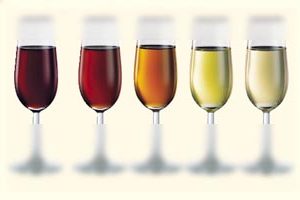Guíto Taste Gourmet wine tasting: the visual phase
Once you are ready for wine tasting, this is quiet place and without noise. without odor and with natural light; glass and proper temperature of the broth perfect, the first observation we make of the wine is the color.
We began the visual phase. The first impression of the wine, obviously, is determined by the aspect; it is the first contact we will have with him, and must have enough power of seduction as to feel the desire to drink it. The color is going to help us determine your body, the age and the state in which is located the wine.

There are four key aspects in this phase:
The clarity of the wine is valued by the suspension of particles that we see in the liquid. The clarity we are going to indicate if the broth is bright, clean, transparent, opaque, cloudy... A white wine, for example, we must present clear and brilliant, as can also happen with the pink.
The fluidity is based on the viscosity of the wine. To do this is to what that we move the cup, before winding down, so we look at the signals that leave us on the side of the cup. If the drops remain attached to the glass descend irregularly, we say that the wine cries a product of the condensation by evaporation of alcohol. If it shows viscous we realize that the wine in question has a lot of alcohol and sugar.
The transparency we determine if the wine is clean and bright. A view smooth will cause the wine is soft on the palate.
The hue refers to the age of the wine. A red wine that is young is almost always a tone of bright colour, purple or ruby, but as you get older the red is more evident to be able to get to colours brown. The white, by contrast, when you age, it becomes more yellow, turns to the golden or amber.
The disk is the top of the wine that crowns the glass, and makes mention of the state of evolution of the broth. More stale, the more clear will be the edge of the disc.


